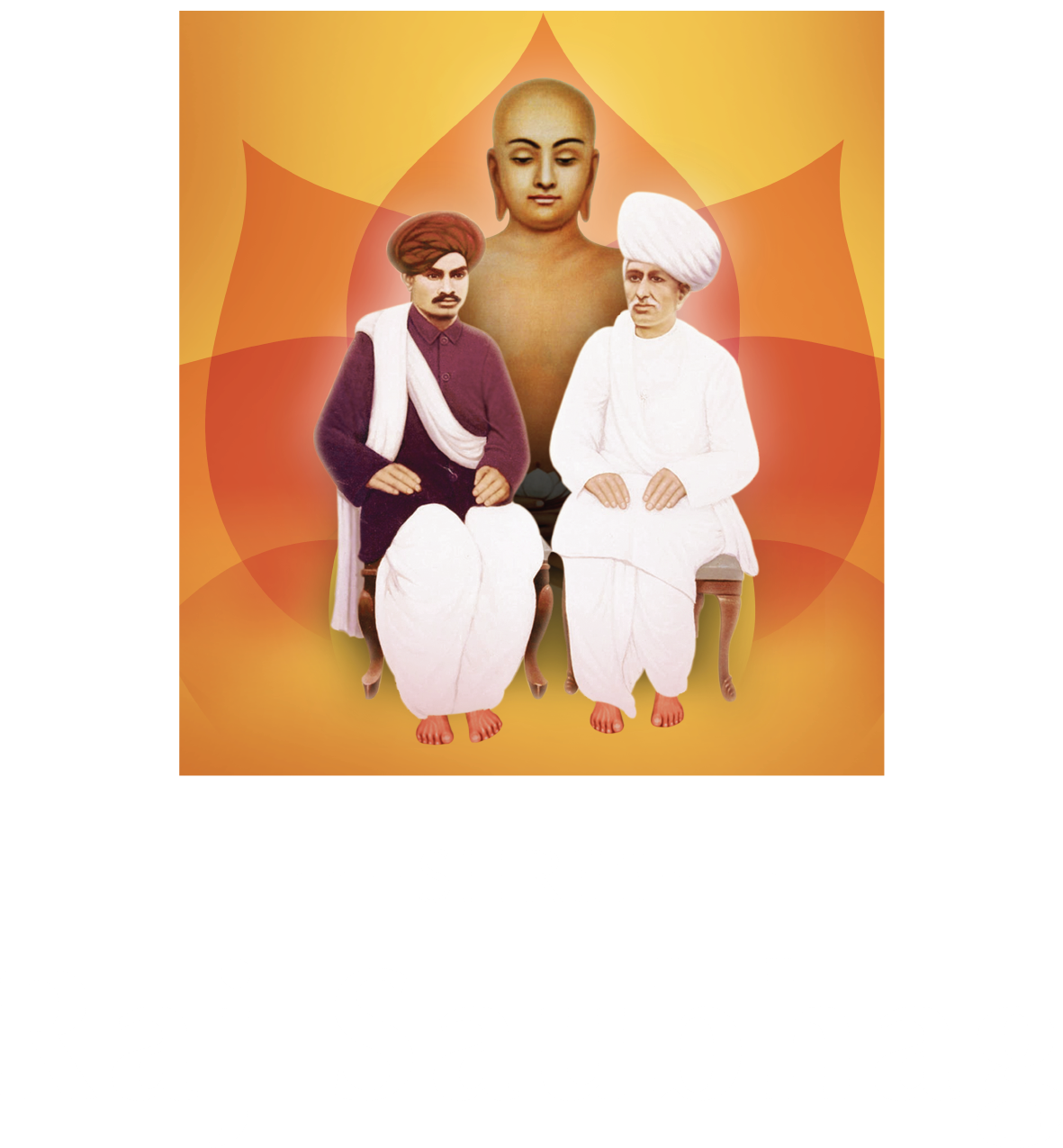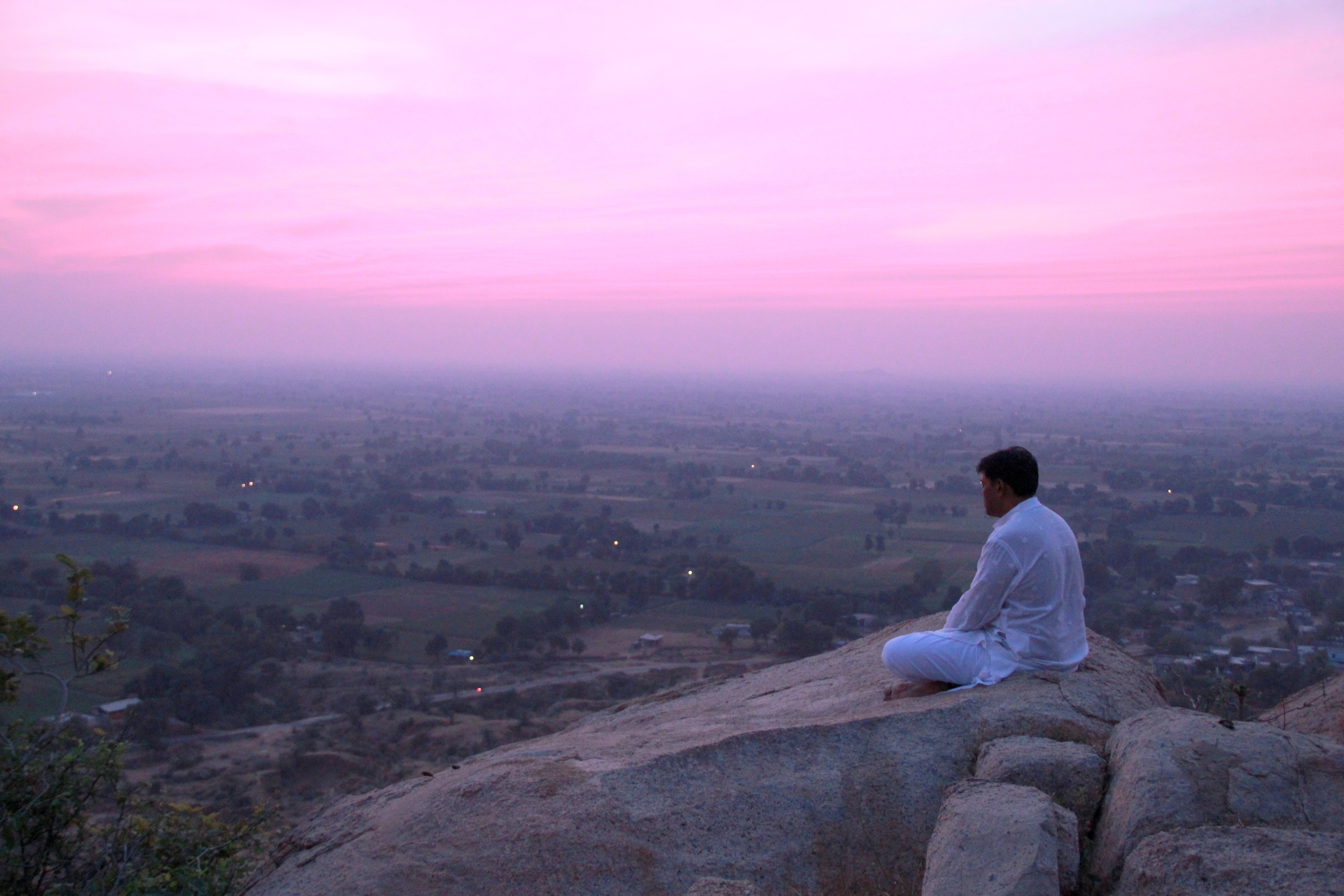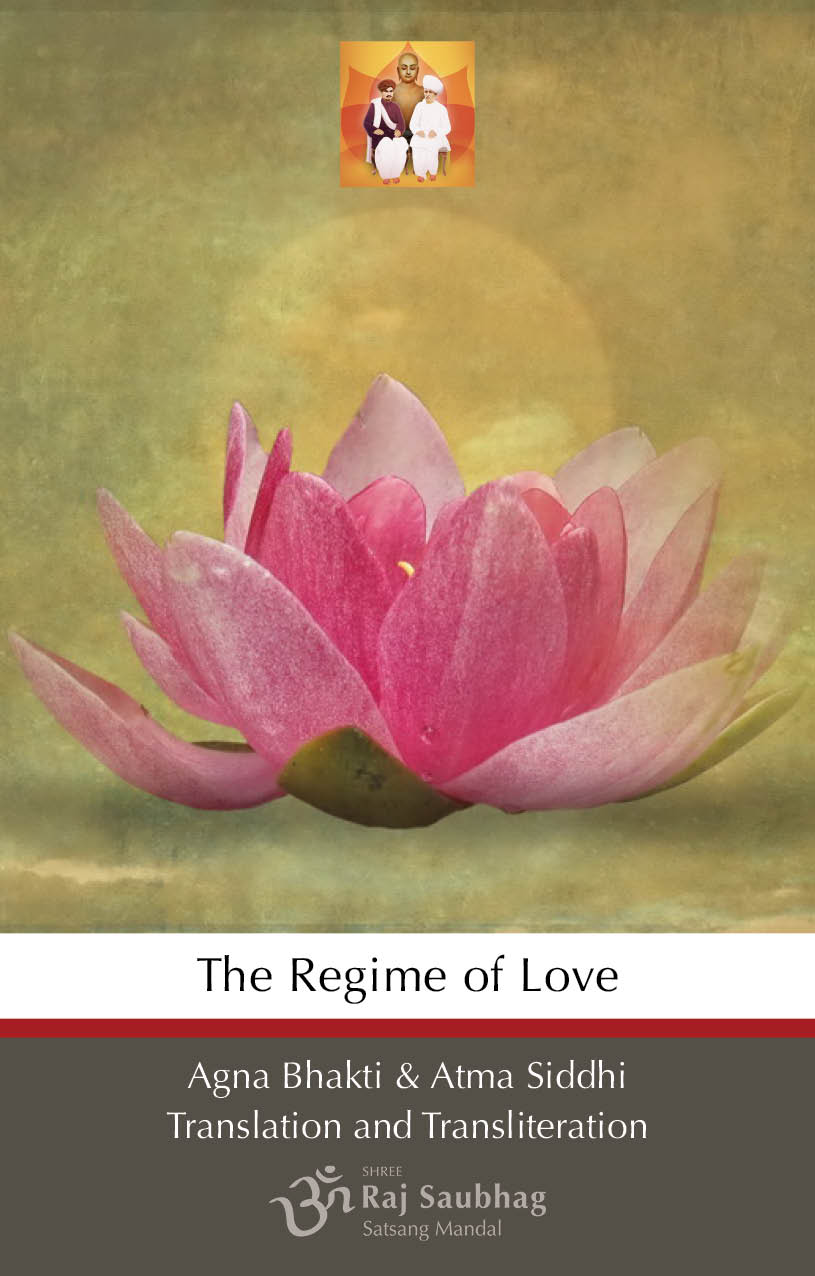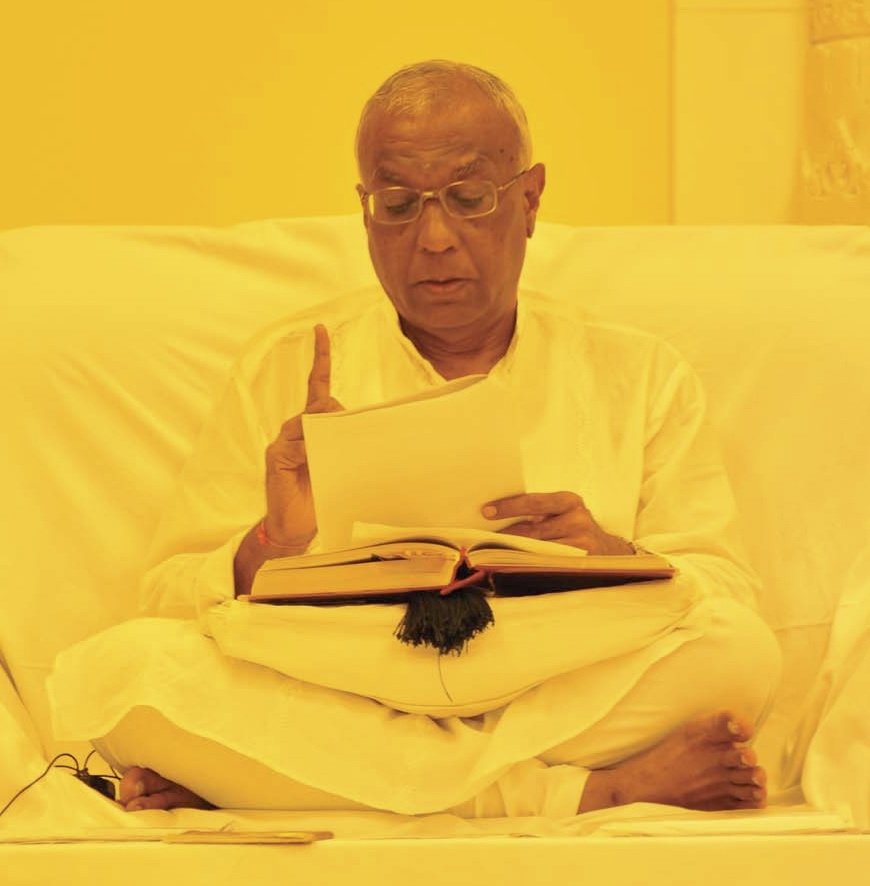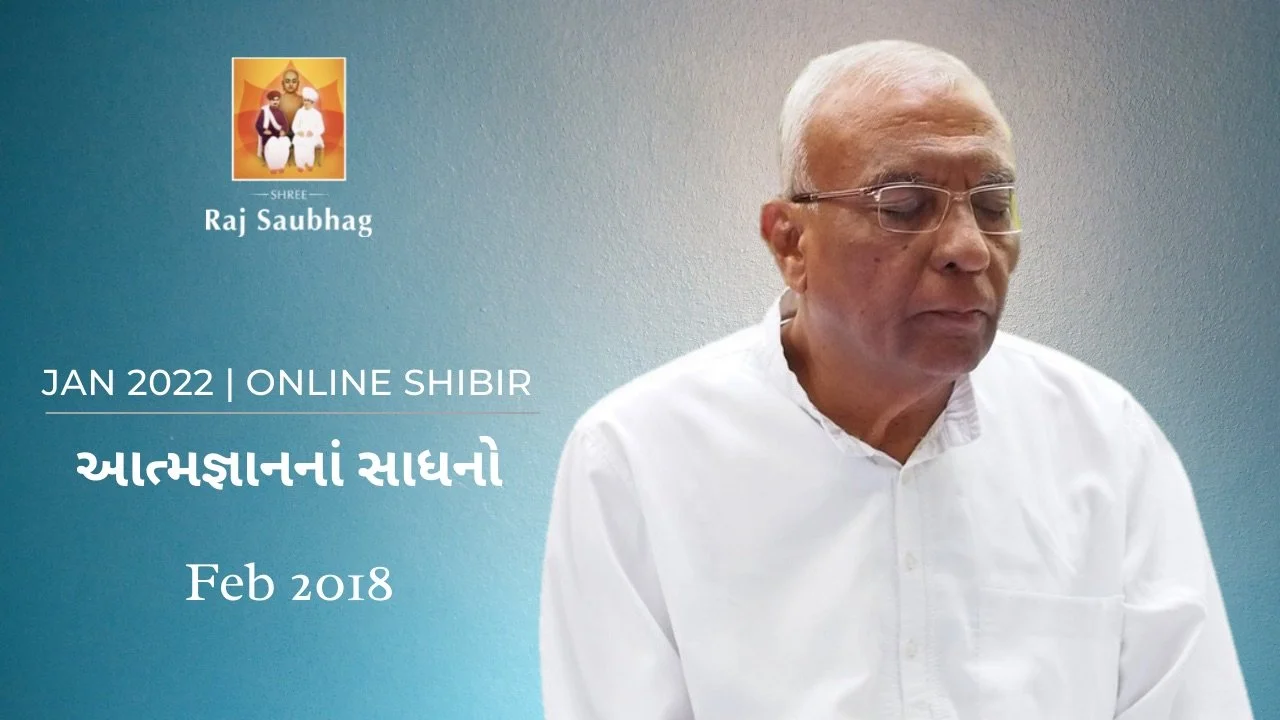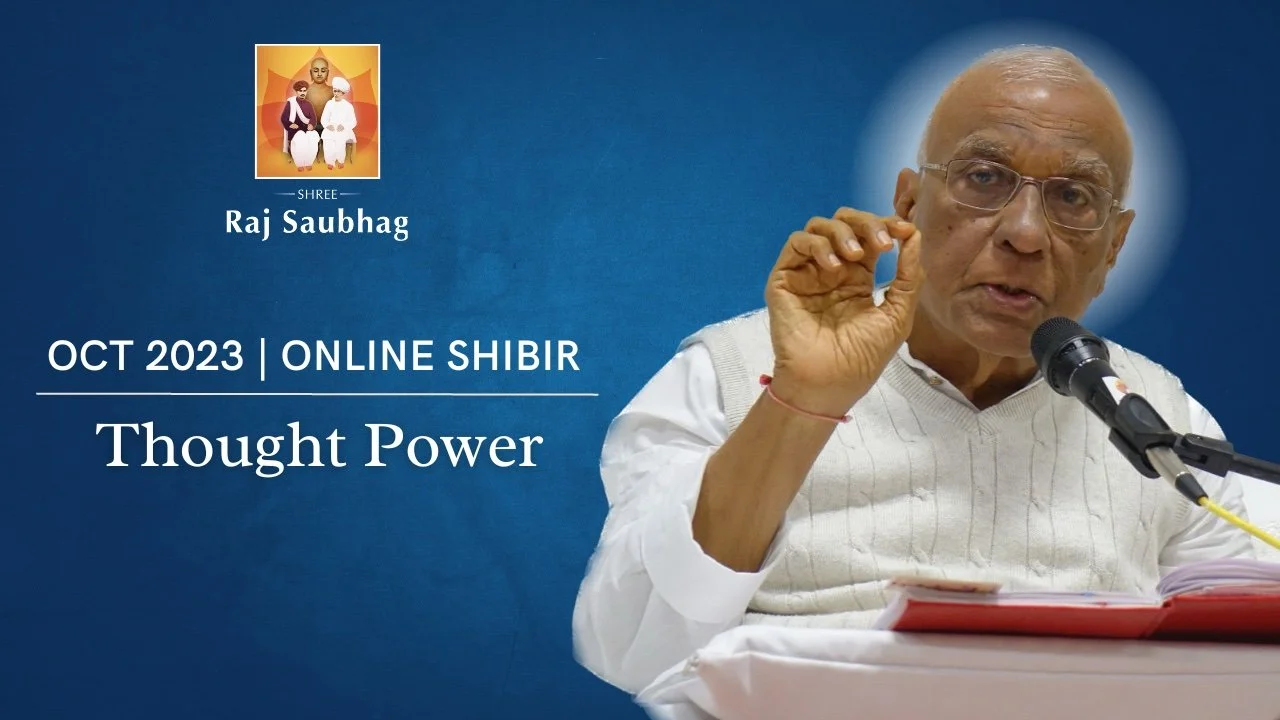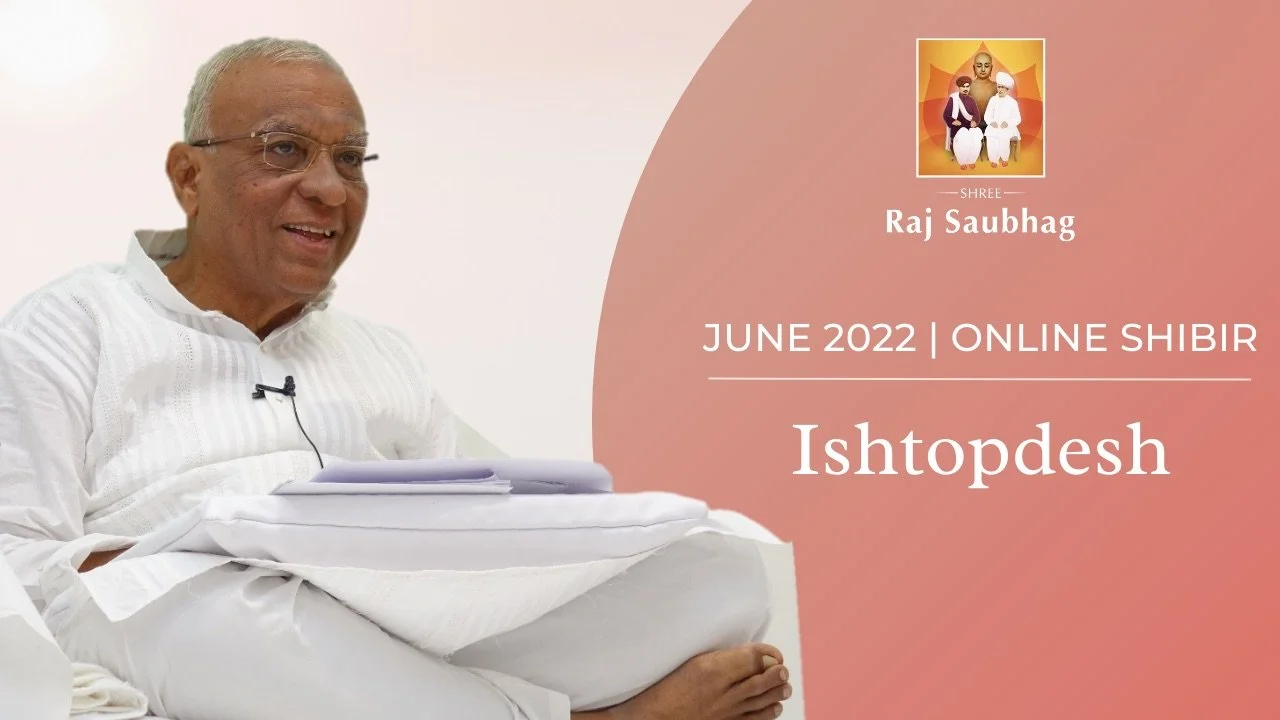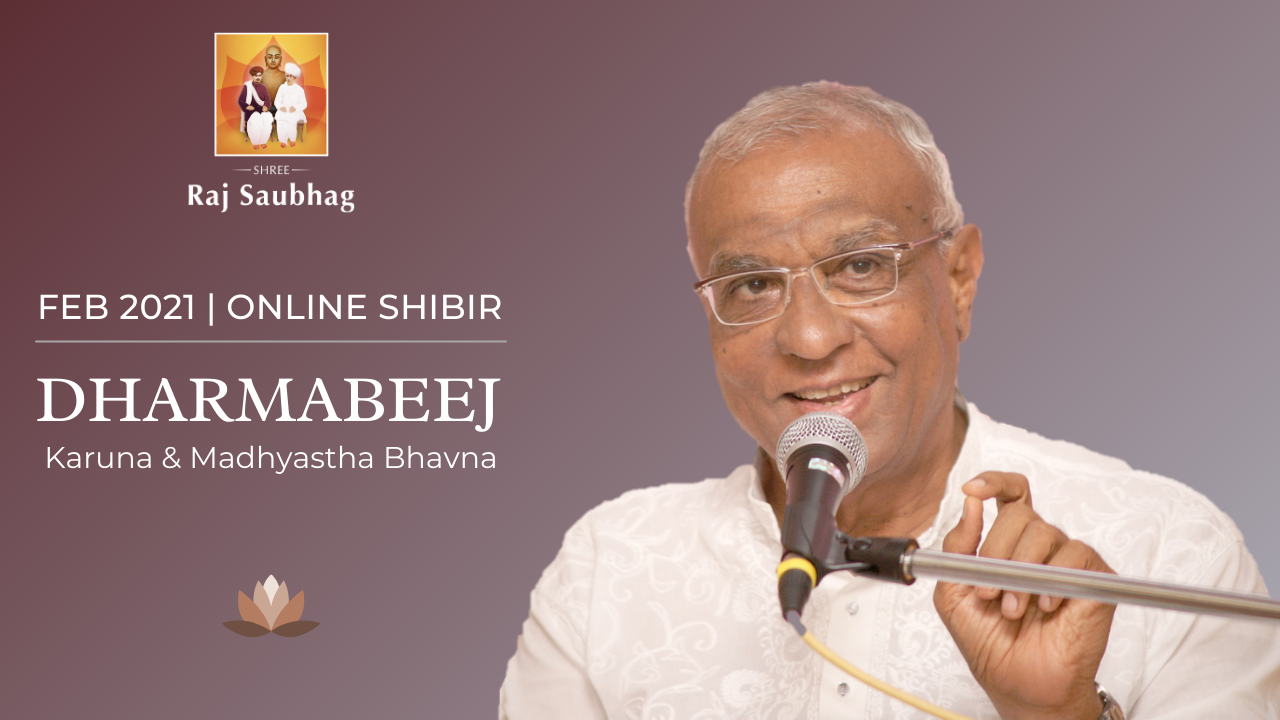
The Spiritual Path
From the moment that we begin to question our place in the world, or the meaning of life, we could be said to have begun our quest for Truth. Shrimad Rajchandra has put these questions to us very beautifully in his “Amulya Tattva Vichar”:
“Who am I? Whence have I come? What is my true nature?”
This Truth lies in our own true nature. When we realise this nature, we know our Self, the Atma, the Soul, and attain Samyag Darshan, Self-Realisation. The moment of Self-Realisation is a moment of jubilation as we experience the ecstasy of our blissful nature for the first time, and it is a turning point in the spiritual journey we have been making in our infinite lifetimes.
Samyag Darshan is a guarantee of the incomparable bliss and freedom we will experience in the State of Moksha. For this is our ultimate goal, the state reached by Bhagwan Mahavir, and all the Tirthankars before him and those yet to come. This state can only ultimately be reached by the adoption of the noble state of asceticism. Even though it is said that Moksha is not possible in this time and place, Samyag Darshan is possible right here and now as long as we strive.
Given our infinite number of lifetimes, why is it that we have not attained this blessed state before? The simple answer from the scriptures and the saints is that we have never surrendered our hubris, Svachhand, the idea that we know it all and that we can practice religion and spirituality as per our own wishes. The reality is that the complex and subtle path to Self-Realisation cannot be understood without the guidance of someone who is himself Self-Realised. We need a True Guru. It is rare indeed to encounter such a living embodiment of the Truth. The True Seeker considers it a great privilege to actually meet such a True Guru: Within the word of a True Guru lies the very key to our own bliss and freedom!
In the Sutrakritanga Sutra (1,2,32), Bhagwan Mahavir is quoted as teaching that an infinite number of souls have attained Moksha by acting according to their Guru’s guidance. “Guruno Chhandanuvattaga”
Such a True Guru is in a state of bliss and does not want anything from us, or from the world, but that we all experience the bliss he is enjoying. We can thus have full faith and trust in him. Our obstructive sectarian prejudices and personal dogmatic obstinacy (both aspects of Matarthi) are easily shed. We are able to surrender to his guidance (Agna), in the full knowledge that it will lead us to Self-Realisation. Acharanga Sutra states: “Agna is Dharma; Agna is Tapa”

Guru - an enlightened master
Indeed, the single most important factor necessary for the seeker to awaken from the slumber of delusion to their true nature of pure awareness beyond the limiting adjuncts of the body, mind and word is the enlightened spiritual master or Guru.
The syllable ‘Gu’ stands for darkness while the syllable ‘Ru’ stands for light – thus the Guru is the compassionate one who leads the seeker from the treacherous darkness of materialistic, mundane existence into the light of self knowledge.
Without a doubt, every religion, every sect, every scripture and every awakened soul are testament to this eternal truth. There can be no inner revolution without the association with the right teacher.
Only a lit flame can enlighten another, so also only a person who has awakened to their true nature and who has experienced the soul can guide the seeker to experience it himself.
What loving devotion towards the enlightened master can bring about, no amount of intellectual pondering or abnegating austerities can ever bring about. It is for this very reason that the scriptures lay utmost emphasis upon dedication and devotion towards the master.
This very truth has been masterfully intertwined in the most fundamental and timeless of Jain prayers – the Navkar Mantra. The reason the Arihants (omniscient preceptors) are bowed to before the Siddhas (or completely liberated souls) is to emphasise the importance of the living master.
The word of the enlightened master, emerging from the very depths of his soul, is like the powerful roar of a lion that can awaken the seeker from the dream of egoistic existence in an instant.
The Practice
In their vision and keenness to help spiritual aspirants, Param Pujya Bapuji and Param Pujya Bhaishree guide seekers through a series of steps along a clear path clear to the goal of self realisation.
The path begins with ‘arpanta’ or surrender unto the master. This is the first step the aspirant takes whereby he accepts the shelter and guidance of the spiritual master or Guru. He symbolically surrenders all his worldly possessions including the mind, body, wealth, property, family etc to the Guru – which is to say that he adopts the realisation that attachment to all these objects is illusory and that it leads to nothing but bereavement and sorrow. Therefore the seeker surrenders all attachment forthese objects to the Guru to relieve himself of their huge burden.
The seeker is then advised to follow basic codes of conduct for leading a pure and simple lifestyle. He is given instructions to read the ‘Shrimad Rajchandra Vachanamrut’ which is a collection of spiritual letters written by Shrimad Rajchandra to some of his closest disciples and which contain the nectarean essence of the path to liberation. This is where the seeker’s true inner development begins for he has now adopted the ‘agna’ or the word of the enlightened master. The scriptures describe this as the proverbial alchemists’ stone that can transform a piece of iron into gold. It is in the steadfast dedication to the word of the master that a magical transformation begins in the seekers life. Numerous virtues take root and vices and passions start shedding. Worldly desires and fears that had always preoccupied the mind lose their grip thanks to the loving devotion towards the benevolent master that fills their heart. The mind that had thus far been an uncontrollable entity, jumping from one thought, sensation, perception and feeling to another slowly starts to become tame and steady.
Seeing the ripeness of the disciple, the Guru blesses him with all his compassion and initiates him into the technique of meditation known as ‘Sudharas’ (nectar of immortality) which is indeed the same technique by which numerous saints of the past including Shrimad Rajchandra had attained the bliss of ‘Sahaj Samadhi’ or the effortless state of abiding in the self. Since time immemorial the flow of conscious attention of the seeker had always been external, flowing out towards the objective world. For the first time ever he has now attained the unprecedented opportunity of turning that flow inwards to look within.
With much patience and care Bhaishree and the Brahmnishts assist the aspirant on this great inner journey. Step by step guidance is provided with continuous personal monitoring and feedback. At the right stage they are advised to engage in deep inner contemplation and self-inquiry. By this combination of stilling the mind in meditative concentration and profound self-reflection, the most esoteric truths automatically begin to dawn upon the seeker.
The sincere and devoted ones that overcome all obstacles both internal and external, eventually experience their true nature as distinct from the materialistic body and the external world. They realise their inherent stillness that has remained unperturbed like the vast ocean remains unaffected by the waves that arise and subside at its surface. Holding on to this eternal stillness that was always their true nature, the disciple can sink into an unfathomable state of ecstatic bliss andexperience his oneness with the lord. The triad of the knower, known and knowing collapse into the singularity of pure, unbound awareness. That which had been sought outside, was always present within all along. By this great realisation, the seeker’s delusion, fears and base desires vaporise. All sense of doership gone, life now becomes a beautiful ballet, full of effortless joy, free from any expectation.
Agna Bhakti
Agna Bhakti, is a collection of prose and poetry about the highest form of love, selfless devotion. Love is the very heart, the very essence, of devotion. Love inspires, motivates, purifies, elevates and ennobles us. This poetry explores and celebrates the impact of love.
It is in this sublime love in the form of faith and devotion towards the True God, True Guru and True Dharma, that lies the path to Moksh.
Love for the True Guru encompasses love for the True God and True Dharma, for he is the embodiment, the exemplar of Truth. We celebrate the presence of a true living Guru in our lives.
As we dedicate our lives to the True Guru, to the path taught by the True Guru, he compassionately creates a daily regimen of spiritual activities for us and instructs us to follow it. If we observe this regime diligently, our striving will be in accordance with truth. By following his regimen we actually celebrate his presence in our lives. With dedication, devotion and trust, our love for the path and the guru grows. We surrender our hubris and self-righteousness at his lotus feet.
Shrimad speaks of this regimen in Atma Siddhi verse 129:
ગુરુ આજ્ઞા સમ પથ્ય નહિ.
Guru aagnaa sam pathya nahi.
There is no regimen like a true guru’s guidance. The Guru’s instruction (Aagna) includes the daily recitation of the poems and prose. The instruction is not mere recitation but contemplation, exploration and immersion in love.
We pray and hope that this regime becomes your daily dose of pure love.
Regime of Love
This book is the collection of Agna Bhakti & Atma Siddhi poetry and prose with both transliteration and translation into English. It is available for free download below.
Video: listen and follow:
This video has the Gujarati alongside English transliteration and translation of Agna Bhakti poetry and prose.
Audio:
Listen to the track by clicking on the play button below:
*(Please wait for a few seconds for the track to play as it is a large file)
Download the individual tracks in the Audio library:
Atma Siddhi
Following a request from Shree Saubhagbhai of Sayla, Shrimad Rajchandra composed the great Atma Sidhi Shastra in the town of Nadiad, Gujarat. The 142 verses emerged in one sitting of less than 2 hours.
This composition explains the Jain path to Moksha. Besides being highly spiritual, it is also a classic of Gujarati literature and has been the subject of numerous translations, commentaries and is also studied at universities for doctorates in philosophy even today.
Audio:
Listen to the track by playing the play button below.
*(Please wait for a few seconds for the track to play as it is a large file)
Watch Param Pujya Bhaishree’s Swadhyays on Shree Atma Siddhi Shastra here
Translation and Transliteration into English
Both Atma Siddhi and Agnabhakti are translated and transliterated into English in the book ‘The Regime of Love’. You can view or download the book for free using the link below.
Background
Shrimad had sent a copy of the letter on 'The Six Spiritual Tenets' to Shri Saubhagbhai with an instruction to learn it by heart and to contemplate on its contents regularly. Due to old age, Saubhagbhai found it difficult to memorise the prose form of the letter and requested Shrimad to re-write the letter in rhythmic verse form so that he could easily memorise it and make it a part of himself.
During Bhadarva and Aso months of Vikram Samvat 1952, Shrimad spent his time in the jungles of Gujarat contemplating in solitude. From there he came to the town of Nadiad where a great event took place on the first day of the later half of the Aso month. When Shrimad returned from his day's outing at dusk, he called on Ambalalbhai: "Ambalal, light and hold a lantern".
Ambalalbhai, a great Truth seeker, humble as ever did as asked and stood by Shrimad's side with a lit lantern. Shrimad sat and started writing. A miraculous stream of inspiration full of profound spiritual insight began to flow. His sublime spritual state became his pen and the essence of his profound thinking became his ink. He began to compose verses with the potency to awaken slumbering souls. The 142 verses of Atma Siddhi Shastra had emerged in one sitting of less than two hours.
Shibirs (Meditation retreats)
To aid aspirants in their practice of meditation, which can often become a difficult task in the midst of worldly lives, meditation retreats or ‘shibirs’ are organised on a monthly basis in the Ashram.
Aspirants who participate in the ‘Maun Aradhana Shibirs’ or silent-solitude retreats observe complete silence for five days and live in solitude. During the day they engage in four hour-long meditation sessions and attend one discourse by Bhaishree where he explains some of the most spiritually significant scriptural compositions.
The feedback that is received after the shibirs truly indicates how deeply transformative these retreats have been for participants.
Dress Code for Shibir
- Fully white coloured clothes (no coloured embroidery / Bharat work on it, white embroidery is ok)
- Dupatta compulsory for females.
- Choose more comfortable bottom wear like salwar, palazzo etc (Avoid tight fitting bottom wear. Leggings / tights will be allowed only if the top is below the knees and it doesn't have a slit.)
Upcoming Shibirs
Aradhana Shibir
Simultaneous to the Ekant Maun Shibir is the Aradhana Shibir. This is open to all, however the meditations are only for those instructed in dhyan. Registration is still required for the Aradhana Shibir but can be done on the day of arrival.
Yuva Shibir
A yuva shibir, held once a year in December, is for those spiritual seekers taking their first steps on the path and is open to all, regardless of age. The Yuva swadhyays or discussions are conducted by Br. Minalben and Br. Vikrambhai in English and simple Gujarati. There is plenty of opportunity for questions as well as meeting Brahmnishts on a one-to-one basis for discussions and clarifications. Registration for the yuva shibir can be done on arrival to the Ashram.
2023/24
Previous Shibirs
Ekant Maun Shibir
Ekant Maun Shibir is a spiritual retreat held for 5 days for intensive spiritual striving in a conducive external environment. Participants stay in silence and in isolation during the entire shibir.
Aspirants who participate in the ‘Ekant maun’ or silent-solitude retreats observe complete silence for five days and live in solitude. During the day they engage in five hour-long meditation sessions and attend one discourse by Bhaishree where he explains some of the most spiritually significant scriptural compositions. Participants provide detailed feedback about their experiences and obstacles in meditation and in-turn receive personalised guidance from the Brahmnishts.
The feedback that is received after the shibirs truly indicates how deeply transformative these retreats have been for participants.Application for shibirs is strict and only open to those Ashram members with dhyan prapti. Acceptance for the shibirs is decided by Param Pujya Bhaishree and Brahmnishts.
Those attending have to abide by strict rules You can download the application form here.
Dress Code for Shibir
- Fully white coloured clothes (no coloured embroidery / Bharat work on it, white embroidery is ok)
- Dupatta compulsory for females.
- Choose more comfortable bottom wear like salwar, palazzo etc (Avoid tight fitting bottom wear. Leggings / tights will be allowed only if the top is below the knees and it doesn't have a slit.)
Ekant Maun Shibir - Rules
Mumukshus are required to arrive the day before the shibir starts, and cannot leave the ashram until the shibir has finished (after the closing ceremony).
Mumukshus must reside in their allocated individual rooms in solitude and in complete silence throughout the shibir.
Eating at night is prohibited. (If there is a medical requirement then permission must be sought by a Brahmnisht who will assess depending on the requirements).
Food must be limited to mealtimes, snacking in rooms is prohibited.
Mumukshus to remain in contemplation and reflection throughout the day and for all activities to be done in such a manner that one remains in constant connection with one’s own soul.
To conduct oneself in a manner to inspire and increase detachment and equanimity will be very useful for the spiritual aspirants who are residing in silence and solitude.
Mumukshus must keenly observe all instructions given by the Brahmnishts who are managing the shibir.
Mumukshus must be seated and present for swadhyay, bhakti, dhyan and satsang, 5 mins prior to the timetabled start time.
Mobile phone use, other phone use, newspapers, letter or other correspondence is prohibited during the shibir. Mobiles phones must be switched off and handed into the office the day before shibir and will be returned after shibir finishes. A list of those who have not handed their phones in is strictly monitored with potential disciplinary action.
Mumukshus may not go outside the Ashram, or the area designated for the Ekant Maun shibir participants.
In breaking any of the above rules, mumukshus must observe any advice or disciplinary action/repentance/penance that the Brahmnishts managing the shibir give.
એકાંત મૌન શિબિરના નિયમો
શિબિરની શરૂઆત થાય તેના આગલે દિવસ મુમુક્ષુઓ હાજર થઈ જવાનું રહેશે અને શિબિર પુરી થાય તે પછી આશ્રમ છોડી શકાશે
શિબિર દરમ્યાન સુમપુર્ણ મૌન સાથે રૂમમાં એકાંતવાસ કરવાનો રહેશે.
રાત્રી ભોજનનો ત્યાગ કરવાનો રહેશે.
યુક્તાહાર / મિતાહાર કરવો, રૂમમાં નાસ્તો કરવો નહિ.
આખો દિવસ આત્માનું અનુસંધાન રહે તે રીતે દરેક ક્રમ ઉપરાંત સતત ચિંતન મનન અને સુવિચારણા કરવાની રહેશે.
મૌનપણે એકાંતમાં રહેતા સાધકને વૈરાગ્ય - ઉપશમભાવ વધે તે પ્રમાણેની ચર્યા ખુબજ ઉપયોગી થશે.
શિબિર સંચાલક તરફથી જે કાંઈ સૂચના આપવામાં આવે તેનું ચુસ્તપણે પાલન કરવું.
સ્વાધ્યાય, ભક્તિ, ધ્યાન અને સત્સંગના સમયે પાંચ મિનિટે પહેલા સ્થાન ગ્રહણ કરી લેવું.
મોબાઈલ, ફોન, છાપું કે પત્ર વ્યવહાર શિબિર દરમ્યાન સંપૂર્ણ બંધ રાખવા.
આશ્રમની બહાર જઈ શકાશે નહિ.
ઉપરોક્ત નિયમનો ભંગ કરનાર સાધકને શિબિર સંચાલક શિક્ષા રૂપે જે કાંઈ પ્રાયશ્ચિત આપે તેનું ચુસ્તપણે પાલન કરવાનું રહેશે
Shibir topic history
2024
Jan - Ishtopdesh
Feb - Samadhi Tantra
March - Yog Shatak
April - Samya Shatak
May - Vairagya Shatak
June - Atmagnan Na Sadhano
2023
Jan - Narad Bhakti Sutra
Feb - Dhyan Adhikar
March - Samya Shatak
April - Dharmabeej
June - Updesh Chhaya 4 & 5
July - Updesh Chhaya 6 & 7
August - Aath Drashti Ni Sajjay
October - Vichar Shakti - Thought Power
December - Shant Sudharas
2022
Jan - Atma Gnan na Sadhano
Feb - Panch Sutra nu Pahelu Sutra
March - Samya Shatak
April - Samyak Darshan
May - Dhyan Adhikar
June - Ishtopdesh
July - Samyaktva na Panch Lakshano
Sept - Bhav Vairagya Shatak
Nov - Yog Shatak
Dec - Atma na Guno
2021
Jan - Yogshatak
Feb - Dharmabeej - Karuna & Madhyasta Bhavna
March - Samyak Darshan
April - Updesh Chhaya 3 & 4
May - Updesh Chhaya 5 & 7
June - Updesh Chhaya 6
July - Updesh Chhaya 8 & 9
Aug - Samadhi Tantra
Oct - Yogshatak
Dec - Narad Bhakti Sutra
2020
Jan - Saamya Shatak
Feb - Samyak Darshan
March -
April -
May - Updesh Chhaya 4 & 5
June -
July - Shant Sudharas - Ashrav and Samvar Bhavna
Sept - Dhyan Adhikar
Oct - Dharmabeej - Maitri & Pramod Bhavna
Dec - Samya Shatak
2019
Jan - Dharmabeej
Feb - Shant Sudharas
March -
April - Dravya Sangrah
May - Dharmabeej
June - Adhyamnasaar
July - Ishtopdesh
Sept - Yog shatak
Nov - Samadhi Tantra
Dec - Samyaktva na 67 Bol
2018
Jan - Moksh Marg Prakash
Feb - Atma Gnan Na Sadhano
March - Ishtopdesh
April - Yogshatak
May (UK) - Updesh Chhaya 4, 5, 6
June - Dharmabeej
July - Samyak Darshan
July - Saamya Shatak
Aug - Adhyatmasaar
Oct - Yogshatak
Dec - Vairagy Shatak
2017
Jan - Updesh Chhaya 6, 8 & 9
Feb - Updesh Chhaya 10, 11
March - Updesh Chhaya 12, 13, 14
April - Panchastikay
May - Panchastikay
June - Vyakhyansar 1 (1 - 101)
July - Vyakhyansar 1 (1 - 101)
Sept - Sanadhi Sukha
Dec - 67 Bol Sazaay
2016
Jan - Samya Shatak
Feb - Dhyan Adhikar
March - Dravya Sangrah
April - Panch Sutra Nu Pahelu Sutra
May - Dharmabeej
June - Ishtopdesh
July - Samaysaar
Nov - Yogshatak
Dec - Updesh Chhaya 3, 4, 5 & 7
2015
Jan -
Feb -
March - Ishtopdesh
April -
May -
May (UK) - Shant Sudharas
June -
July - Tatvarthadhigam Sutra (Adhyay 1 - 5)
Aug - Tatvarthadhigam Sutra (Adhyay 6 - 10
Oct - Yogshatak
Dec - Samyag Darshan
2014
Jan -
Feb -
March -
April -
May -
June -
July -
Sept -
Nov -
Dec -
